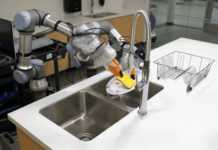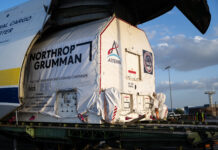NASA’s Ames Research Center: A Crucial Contributor to the Artemis II Mission
NASA is on the brink of another historic venture as it prepares to send astronauts to the Moon on the Orion spacecraft. A significant part of this ambitious mission relies on the expert research, testing, and development conducted at NASA’s Ames Research Center located in California’s Silicon Valley. This center has been pivotal in ensuring the success of the Orion Program, a cornerstone of NASA’s Artemis missions aimed at lunar exploration.
Recently, Ames had the privilege of hosting an esteemed group of visitors: Artemis II astronauts Christina Koch and Victor Glover, along with Orion leaders Debbie Korth, the deputy program manager, and Luis Saucedo, the deputy crew and service module manager. The purpose of their visit was to tour the Ames facilities that are instrumental in supporting the Orion Program and to acknowledge the dedicated efforts of the employees who contribute to its success.
Exploring the Arc Jet Complex: Simulating Extreme Conditions
The visit commenced at the Arc Jet Complex, a state-of-the-art facility where researchers simulate the intense heat of atmospheric reentry using extremely hot, high-speed gases. This simulation is crucial for understanding how different materials and systems perform under the extreme conditions experienced during reentry into Earth’s atmosphere. The insights gained here are vital for ensuring that the spacecraft’s thermal protection system can withstand the rigors of space travel and return.
Following this, the visitors explored the Sensors & Thermal Protection Systems Advanced Research Laboratories. Here, a dedicated team focuses on developing cutting-edge sensors and flight instruments that measure the heat shield’s response during a mission. These systems are integral to the development and testing of Orion’s thermal protection system, which is essential for safeguarding astronauts during their journey.
Addressing Heat Shield Challenges: Learning from Artemis I
The successful return of the Artemis I Orion spacecraft marked a significant achievement. However, it also revealed an unexpected challenge: charring loss on the heat shield. Ames researchers played a crucial role in analyzing this issue, providing insights that will inform future missions. By understanding the causes of this charring and addressing them, NASA can enhance the safety and reliability of the Orion spacecraft as it embarks on more missions to the Moon and beyond.
Acknowledging Excellence: Celebrating Ames Employees
The highlight of the visit was an award ceremony recognizing the outstanding performance and dedication of Ames employees. Thirty-two individuals were honored for their exceptional contributions, whether as part of a team or through individual efforts. These awards underscore the critical role that the Ames workforce has played in the development, testing, and validation of the Orion spacecraft’s thermal protection system. Their work also extends to supporting the spacecraft’s software and systems for guidance, navigation, and control.
Eugene Tu, the center director at NASA Ames, expressed his pride in the accomplishments of the Ames team. “The Ames workforce has played an important role in developing, testing, and validating the Orion spacecraft’s thermal protection system as well as supporting its software and guidance, navigation, and control,” Tu stated. “I’m pleased to see their contributions recognized and celebrated by program leadership and two of the astronauts whose safety and success were in mind when ensuring these systems are safe, reliable, and the highest quality possible.”
Understanding Key Terminologies and Their Importance
For those new to space exploration terminology, understanding some key concepts can enhance appreciation of the work being done. The “thermal protection system” refers to the materials and technologies used to protect spacecraft from the extreme heat generated during reentry into Earth’s atmosphere. This system is crucial for keeping the spacecraft—and its crew—safe upon return from space.
The “Arc Jet Complex” is a facility where scientists recreate the high-temperature conditions experienced during reentry by using jets of hot, high-speed gases. This testing is essential for evaluating how materials will behave when subjected to such intense heat, ensuring they can protect the spacecraft effectively.
Looking Ahead: The Future of Artemis Missions
The Artemis II mission represents a significant step forward in NASA’s plan to return humans to the Moon and eventually send astronauts to Mars. The insights and advancements made at the Ames Research Center are not only crucial for the success of the Artemis II mission but also pave the way for future explorations. These missions will not only expand our understanding of the Moon but also serve as a proving ground for technologies and systems that will be used in Mars missions.
In conclusion, the work being done at NASA’s Ames Research Center exemplifies the collaboration, innovation, and dedication required to push the boundaries of human space exploration. As the world watches NASA’s progress, the contributions of the Ames team are a testament to the spirit of exploration and discovery that defines NASA’s mission. For more detailed information about the Orion Program and NASA’s Artemis missions, you can visit their official website.
For more Information, Refer to this article.


































